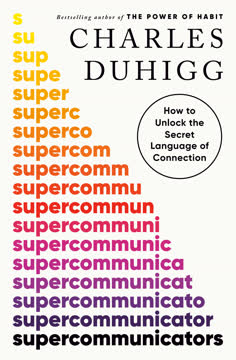Key Takeaways
1. Co-elevation: The New Work Paradigm for Leading Without Authority
Co-elevation is a mission-driven approach to collaborative problem-solving through fluid partnerships and self-organizing teams.
The new work world demands a fundamental shift in how we approach leadership and collaboration. Co-elevation is the answer to this challenge, providing a framework for leading without formal authority. It emphasizes going higher together, nurturing a generosity of spirit and commitment to shared missions.
Co-elevation principles:
- Collaborative problem-solving
- Fluid partnerships
- Self-organizing teams
- Mutual accountability
- Candid feedback
By embracing co-elevation, individuals can extend their reach and accomplishments far beyond the limits of their assigned responsibilities, achieving transformative outcomes and fostering innovation in the face of disruption.
2. Redefine Your Team Beyond Organizational Boundaries
Your team is made up of everyone—inside and outside the company—important to achieving your project or mission.
Expand your definition of "team" to include anyone critical to your success, regardless of their position in the organizational hierarchy. This broader perspective allows you to tap into a wider range of resources and expertise.
Key aspects of redefining your team:
- Look beyond direct reports and immediate colleagues
- Include cross-functional partners
- Consider external stakeholders and even competitors
- Focus on shared goals and missions
By adopting this inclusive approach, you can create more diverse and effective teams capable of tackling complex challenges and driving innovation. Remember, your ability to influence and collaborate with this expanded team is crucial for achieving exceptional results.
3. Take Full Responsibility for Your Success and Relationships
If you're going to wait for everyone else to change, you might as well put your career on hold and be resigned to underperforming for your patients.
Embrace "extreme ownership" of your career and relationships. Recognize that your success depends on your ability to build and nurture productive relationships with others, even those you may find challenging.
Overcome these common excuses:
- "It's not my job"
- "They won't listen anyway"
- "I don't have the authority"
- "It's too difficult"
Instead, focus on what you can control: your own actions and attitudes. Take the initiative to reach out, build connections, and contribute value to your expanded team. By accepting that "it's all on you," you empower yourself to create positive change and achieve your goals, regardless of your formal position or authority.
4. Earn Permission to Lead Through Serving, Sharing, and Caring
Nobody cares how much you know until they know how much you care.
Build trust and influence by demonstrating genuine care and commitment to others' success. This approach opens doors to deeper collaboration and allows you to lead without formal authority.
Key strategies for earning permission to lead:
- Serve: Actively look for ways to help others succeed
- Share: Be vulnerable and open about your own experiences and challenges
- Care: Show authentic interest in others' well-being and growth
By consistently demonstrating these behaviors, you create psychological safety and open porosity with your teammates. This foundation of trust enables you to offer candid feedback, challenge ideas constructively, and inspire others to join your mission.
5. Foster Deeper, More Collaborative Partnerships
Transformative Outcomes = Radical Inclusion + Bold Input + Agility
Create an environment that encourages diverse perspectives, honest feedback, and rapid iteration. This formula for co-elevating collaboration leads to breakthrough solutions and accelerated innovation.
Key elements of collaborative partnerships:
- Radical inclusion: Actively seek input from a wide range of voices
- Bold input: Encourage candid, courageous feedback and ideas
- Agility: Embrace rapid experimentation and iteration
Implement practices like:
- Collaborative Problem Solving (CPS) sessions
- Regular check-ins and feedback loops
- Cross-functional team structures
By fostering this type of collaborative environment, you can tap into the collective intelligence of your team and achieve transformative outcomes that surpass what any individual could accomplish alone.
6. Embrace Peer-to-Peer Development and Coaching
We each need to take responsibility for coaching and developing the members of our teams, and we need to seek their coaching as well.
Create a culture of mutual growth by normalizing peer-to-peer coaching and development. This approach fills the gap left by traditional hierarchical mentoring structures and accelerates individual and team growth.
Key aspects of peer-to-peer development:
- Give and receive candid feedback
- Focus on both hard and soft skills
- Create psychological safety for honest conversations
- Celebrate growth and improvement
Implement practices like:
- Regular co-development check-ins
- Peer coaching circles
- Skills-sharing sessions
By fostering a environment where everyone is both a teacher and a learner, you create a more agile, resilient, and high-performing team capable of adapting to rapid change and seizing new opportunities.
7. Cultivate a Culture of Praise and Celebration
What we reward with praise is what others will aspire to achieve. What we celebrate is what we will receive.
Harness the power of positive reinforcement to drive desired behaviors and outcomes. Regular praise and celebration create a more engaging work environment and reinforce the co-elevation mindset.
Strategies for effective praise and celebration:
- Make it personal and specific
- Celebrate small wins and progress, not just big achievements
- Recognize effort and growth, not just results
- Encourage peer-to-peer recognition
Benefits of a praise-rich culture:
- Increased motivation and engagement
- Enhanced psychological safety
- Reinforcement of desired behaviors
- Stronger team bonds
By consistently praising and celebrating co-elevation behaviors and outcomes, you create a virtuous cycle that drives continuous improvement and strengthens your team's collaborative culture.
8. Create a Co-elevation Movement in Your Organization
Transformation on this level is a team sport, and we all have to play an active role in it.
Spread the co-elevation mindset throughout your organization to create lasting cultural change. By inspiring others to adopt co-elevation principles, you can spark a movement that transforms your entire workplace.
Steps to create a co-elevation movement:
- Start with a small, committed core group
- Model co-elevation behaviors consistently
- Celebrate and share success stories
- Provide tools and resources for others to learn and practice
- Encourage others to become co-elevation champions
As the movement grows, it becomes self-sustaining, with new co-elevators inspiring and teaching others. This ripple effect can lead to a fundamental shift in how your organization operates, fostering greater innovation, engagement, and overall performance.
Remember, cultural transformation starts with individual actions. By consistently practicing and promoting co-elevation, you can be the catalyst for positive change in your workplace and beyond.
Last updated:
FAQ
What's Leading Without Authority about?
- Core Concept: The book by Keith Ferrazzi emphasizes that leadership is not about titles or authority but about inspiring and leading through collaboration and relationship-building.
- Co-Elevation Method: It introduces "co-elevation," a mission-driven approach to collaborative problem-solving, encouraging teamwork across functions and hierarchies.
- New Work Rules: The book outlines new rules for the modern workplace, focusing on radical interdependence and the need for everyone to take initiative.
Why should I read Leading Without Authority?
- Transformative Leadership Skills: It provides practical strategies for developing essential leadership skills in collaborative environments, teaching how to lead without formal authority.
- Real-World Examples: The author shares anecdotes and case studies from coaching executives and teams, illustrating the effectiveness of leading without authority.
- Empowerment for All: The book empowers individuals at any level to take charge and contribute meaningfully, encouraging a mindset shift for personal and professional growth.
What are the key takeaways of Leading Without Authority?
- Redefining Leadership: Leadership is about influence and impact, not just titles, encouraging readers to see themselves as leaders regardless of their roles.
- Importance of Relationships: Building strong, collaborative relationships is crucial for success, with every employee able to lead by fostering connections and trust.
- Co-Elevation Framework: The book introduces a framework for co-elevation, including serving, sharing, and caring for teammates to enhance collaboration.
What is co-elevation, and how is it defined in Leading Without Authority?
- Definition of Co-Elevation: Co-elevation is a mission-driven approach to collaborative problem-solving through fluid partnerships and self-organizing teams.
- Guiding Ethos: The ethos of co-elevation is "going higher together," fostering generosity and commitment among team members.
- Transformative Outcomes: Practicing co-elevation leads to outcomes exceeding traditional hierarchical structures, empowering team members to contribute to innovation.
What are the seven rules outlined in Leading Without Authority?
- Rule One: Who’s Your Team?: Recognize that your team includes everyone critical to achieving your goals, expanding influence and collaboration.
- Rule Two: Accept That It’s All on You: Take responsibility for leading and influencing others, regardless of formal authority.
- Rule Three: Earn Permission to Lead: Build trust and rapport to gain permission to lead, involving serving, sharing, and caring for others.
- Rule Four: Create Deeper Partnerships: Foster inclusive relationships that drive innovation and success through open communication and shared goals.
- Rule Five: Co-Development: Engage in peer-to-peer coaching to enhance team performance, strengthening relationships and outcomes.
How does Leading Without Authority address the challenges of modern workplaces?
- Focus on Collaboration: The book advocates moving away from traditional hierarchies to embrace collaborative, cross-functional teams.
- Empowerment and Initiative: It encourages employees to take initiative and seize leadership opportunities, regardless of formal roles.
- Cultural Transformation: The author calls for a cultural shift valuing collaboration, trust, and mutual support to thrive in rapid change.
What is the Collaborative Problem-Solving (CPS) method mentioned in Leading Without Authority?
- Structured Approach: CPS involves breaking down complex issues into manageable parts, encouraging collaboration in small groups.
- Focus on Inclusivity: It ensures all voices are heard, leading to richer discussions and innovative solutions.
- Psychological Safety: CPS fosters a safe environment for sharing bold ideas, crucial for creativity and collaboration.
What role does psychological safety play in Leading Without Authority?
- Foundation for Co-Elevation: Psychological safety is essential for co-elevation, allowing team members to express thoughts freely.
- Encourages Risk-Taking: It enables team members to take risks and share innovative ideas, driving creativity and problem-solving.
- Reduces Fear of Failure: Psychological safety reduces fear of failure, allowing teams to learn from mistakes and improve continuously.
How can I implement the principles from Leading Without Authority in my workplace?
- Start Small: Apply co-elevation principles in your immediate team, focusing on building relationships and open communication.
- Encourage Feedback: Create a culture of feedback with regular check-ins and open discussions to maintain transparency and trust.
- Lead by Example: Model behaviors like generosity and collaboration to inspire others to adopt the same mindset.
What are some practical strategies for leading without authority from Leading Without Authority?
- Build Relationships: Develop authentic relationships with colleagues, being genuinely curious about their needs and aspirations.
- Serve and Share: Approach interactions with a service mindset, helping others succeed and sharing experiences to foster trust.
- Communicate Openly: Maintain open communication and encourage candid feedback to create a culture of trust and collaboration.
What are the best quotes from Leading Without Authority and what do they mean?
- “Position does not define power—impact defines power.”: Leadership comes from influence and making a difference, not from titles.
- “We need to do work so great that you couldn’t possibly do it alone.”: Collaboration and teamwork are essential for significant outcomes.
- “Every employee, from the mailroom to the C-suite, can be a leader.”: Leadership potential exists at all levels, encouraging initiative and collaboration.
How does Leading Without Authority define co-elevation?
- Mutual Support: Co-elevation involves mutually supporting and uplifting each other to achieve shared goals.
- Collective Responsibility: It requires collective responsibility to ensure no one is left behind, fostering collaboration and accountability.
- Transformational Impact: Co-elevation leads to transformational changes, enhancing performance and creating an engaged workforce.
Review Summary
The reviews for Leading Without Authority are mixed. Some readers praise its insights on collaborative leadership and "co-elevation," finding it valuable for modern workplaces. Others criticize it as repetitive, overly simplistic, and lacking diverse perspectives. Positive reviews highlight practical advice for building stronger teams and fostering collaboration. Negative reviews argue the book rehashes common ideas and fails to address challenging scenarios. Overall, readers' experiences vary greatly, likely influenced by their existing workplace cultures and leadership philosophies.
Similar Books










Download PDF
Download EPUB
.epub digital book format is ideal for reading ebooks on phones, tablets, and e-readers.






